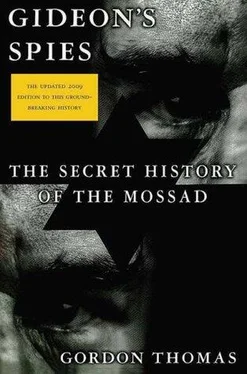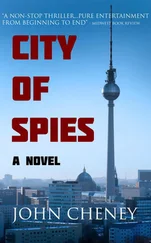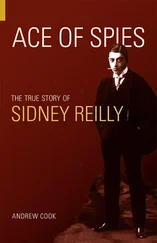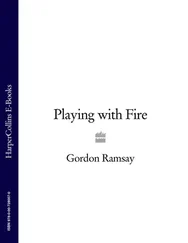Gordon Thomas - Gideon's Spies
Здесь есть возможность читать онлайн «Gordon Thomas - Gideon's Spies» весь текст электронной книги совершенно бесплатно (целиком полную версию без сокращений). В некоторых случаях можно слушать аудио, скачать через торрент в формате fb2 и присутствует краткое содержание. Город: New York, Год выпуска: 2009, ISBN: 2009, Издательство: Thomas Dunne Books, Жанр: История, на английском языке. Описание произведения, (предисловие) а так же отзывы посетителей доступны на портале библиотеки ЛибКат.
- Название:Gideon's Spies
- Автор:
- Издательство:Thomas Dunne Books
- Жанр:
- Год:2009
- Город:New York
- ISBN:978-0-312-53901-6
- Рейтинг книги:4 / 5. Голосов: 1
-
Избранное:Добавить в избранное
- Отзывы:
-
Ваша оценка:
- 80
- 1
- 2
- 3
- 4
- 5
Gideon's Spies: краткое содержание, описание и аннотация
Предлагаем к чтению аннотацию, описание, краткое содержание или предисловие (зависит от того, что написал сам автор книги «Gideon's Spies»). Если вы не нашли необходимую информацию о книге — напишите в комментариях, мы постараемся отыскать её.
Gideon’s Spies
Gideon's Spies — читать онлайн бесплатно полную книгу (весь текст) целиком
Ниже представлен текст книги, разбитый по страницам. Система сохранения места последней прочитанной страницы, позволяет с удобством читать онлайн бесплатно книгу «Gideon's Spies», без необходимости каждый раз заново искать на чём Вы остановились. Поставьте закладку, и сможете в любой момент перейти на страницу, на которой закончили чтение.
Интервал:
Закладка:
In 1981, William Casey, a devout Catholic, was the CIA director. He had been among the first men the pope received in private audience after being elected. Casey had knelt before the charismatic Polish pope and kissed the Fisherman’s Ring on his finger. In every word and gesture, the CIA director was a humble supplicant, not like the bombastic, hard-bitten men his predecessors had been. But Casey shared their and the pope’s deep distrust and fear of Communism.
For over an hour the two men discussed issues dear to them. Where should Ostpolitik go now? How would the Polish regime, indeed the whole of the Soviet Bloc, respond to the change in direction the Church must now take? Casey left the audience chamber sure of one thing: John Paul was not a man to seek easy accommodations. That was what made him so charismatic. His clean-cut beliefs were the best possible answer to that tired old question, the one Stalin was supposed to have posed about how many divisions a pope had. John Paul, Casey believed, was a pontiff who single-handedly would prove that faith could be more effective than any force.
Casey returned to Washington to brief President Reagan, who told the CIA director to return to Rome and tell the pope, under a secret arrangement the president approved, that from now on he would be kept fully informed on all aspects of U.S. policy—military, political, and economic.
Every Friday evening the CIA station chief in Rome brought to the Apostolic Palace the latest secrets obtained from satellite surveillance and electronic eavesdropping by CIA field agents. No other foreign leader had access to the intelligence the pope received. It enabled the most political of all modern pontiffs to stamp his distinctive style and authority on both the Church and the secular world. Papal diplomacy, the political core of a highly centralized Vatican bureaucracy, had, more than at any time in its five hundred years of very active history, become deeply involved with international events. As a world leader, this involvement had nearly cost the pope his life when he was almost assassinated in St. Peter’s Square on May 13, 1981.
Two years later, on November 15, 1983, a cold winter’s night in Rome, John Paul was about to learn the answer to a question that still consumed him: Who had ordered the assassination? Every moment of what had happened had been seared forever into his memory and remained as vivid as the scar tissue from his bullet wounds.
There had been about one hundred thousand people in St. Peter’s Square on that Wednesday afternoon, May 13, 1981. They were packed within the three-quarter circle encompassing Bernini’s colonnades—284 columns and 88 pilasters, themselves supporting 162 statues of the saints. A fenced-off route indicated the path the popemobile would travel to the platform from which John Paul delivered his weekly address. There was a festive air and some of the onlookers speculated what the pontiff would be doing in the Papal Apartments while they waited.
What went on in the mind of a swarthy young Turk, Mehmet Ali Agca, would not be known. He had arrived in the square in midafternoon and worked his way close to the path along which the popemobile would trundle. Agca had been a member of a terrorist group based in Turkey that called itself the Gray Wolves. But he had left their ranks and traveled through the Middle Eastern training camps of even more extreme Islamic fundamentalist groups. Now he was almost at the end of his journey. Agca was in St. Peter’s Square not to praise but to kill the pope.
At four o’clock John Paul had changed into a freshly pressed pristine white silk cassock. On the advice of the CIA, the garment had been cleverly modified to enable a flak jacket to be worn undetected beneath the garment. On his last visit to the Apostolic Palace, Casey had warned John Paul that “in these crazy times, even the pope was not above attack. I told him we had no hard evidence he was in danger. But John Paul was a very controversial figure and a fanatic could try to kill him.”
John Paul had refused to wear the protection. The very idea, he had told his English-language secretary, Monsignor John Magee, went against all his papacy represented.
John Paul descended to the San Damaso Courtyard inside the Apostolic Palace at 4:50 P.M. The Vatican’s security chief, Camillo Cibin, ticked off the pontiff’s approach on his copy of the minute-by-minute schedule that governed the pope’s working day. In the jacket of Cibin’s custom-made steel gray suit was a small but powerful cellular phone linking him to Rome police headquarters. But the immediate protection of the pontiff was in the hands of blue-suited Vigili. The Vatican’s small but highly trained security force were the sharp eyes behind the ceremonial Swiss Guards already positioned in St. Peter’s Square.
Parked in the courtyard was the popemobile, or campagnola, with its white-leather padded seat and handrail for the pope to grip during his progress through the vast piazza. Gathered around the vehicle were senior members of his staff. Magee would remember that John Paul was in “unusually good form.”
At five o’clock precisely, the popemobile drove out of the courtyard. Ahead, from St. Peter’s Square, the cheering began. As the campagnola approached the Arch of the Bells, the Vigili were joined by Rome city policemen, who walked ahead and immediately behind the vehicle. As the popemobile emerged into the piazza, the crowd noise rose to a roar. John Paul waved and smiled; his time as an actor in his youth had given him a powerful stage presence.
At two miles an hour, the pope turning from one side to the other, the vehicle moved toward the Egyptian obelisk in the center of the piazza. At exactly 5:15 P.M. the campagnola began a second circuit of the square under the watchful eyes of Cibin; the security chief was trotting behind the popemobile. The crowd’s cheering was even wilder. Impetuously, John Paul did something that always made Cibin nervous. The pope reached into the crowd and plucked out a child. He hugged and kissed the little girl and then handed her back to her ecstatic mother. It was part of the pontiff’s routine. Cibin’s concern was that a child would wriggle free of the pope’s grasp and fall, creating a nasty accident. But John Paul had dismissed all such concerns.
At 5:17 P.M. he once more reached out to touch the head of another little girl, dressed in communion white. Then he straightened and looked about him, as if wondering who else he might greet. It was his way of personalizing the papacy in even the largest of crowds.
Furthest from his mind at that moment were the dangers he had faced in other crowds. Only three months before—in Pakistan, on February 16, 1983—a bomb had exploded in Karachi’s municipal stadium shortly before he began his journey among the faithful. In January 1980 the French secret service had warned of a Communist plot to kill him. It was just one of scores of threats the Vatican had received against the pope’s life. All had been investigated as far as was possible. Later Magee said: “In reality we could only sit and wait. Short of enclosing the Holy Father in a bulletproof cage whenever he appeared in public, something he would never agree to, there was not much else we could do.”
At 5:18 P.M. the first shot rang out in St. Peter’s Square.
John Paul remained upright, his hands still gripping the handrail. Then he started to sway. Mehmet Ali Agca’s first bullet had penetrated his stomach, creating multiple wounds in the small intestine, the lower part of the colon, the large intestine, and the mesentery, the tissue that holds the intestine to the abdominal wall. Instinctively, John Paul placed his hand over the entry wound to try to stop the spurting blood. His face increasingly filled with pain and he slowly began to collapse. Only seconds had passed since he had been hit.
Читать дальшеИнтервал:
Закладка:
Похожие книги на «Gideon's Spies»
Представляем Вашему вниманию похожие книги на «Gideon's Spies» списком для выбора. Мы отобрали схожую по названию и смыслу литературу в надежде предоставить читателям больше вариантов отыскать новые, интересные, ещё непрочитанные произведения.
Обсуждение, отзывы о книге «Gideon's Spies» и просто собственные мнения читателей. Оставьте ваши комментарии, напишите, что Вы думаете о произведении, его смысле или главных героях. Укажите что конкретно понравилось, а что нет, и почему Вы так считаете.












